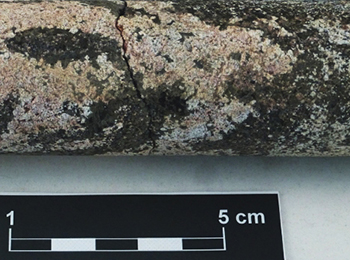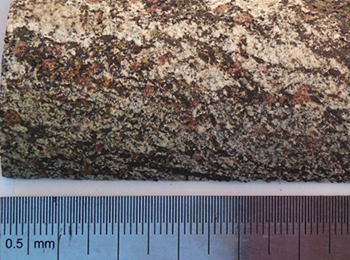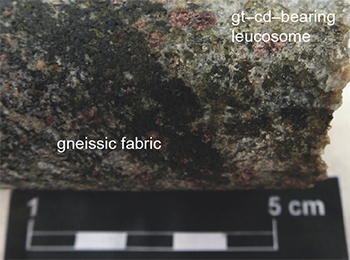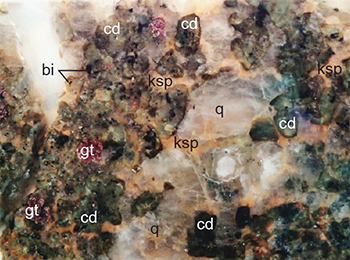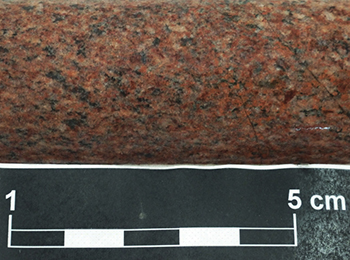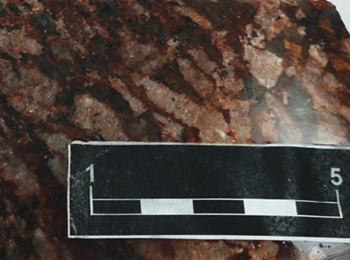Laura Morrissey1, 2, Karin Barovich2, Martin Hand2, Katherine Howard2, Justin Payne1 and Anthony Reid3
1 School of Natural and Built Environments, University of South Australia
2 School of Physical Sciences, University of Adelaide
3 Geological Survey of South Australia, Department for Energy and Mining
Download this article as a PDF (3.4 MB); cite as MESA Journal 88, pages 4–11
Published October 2018
Introduction
Figure 1 (a) Interpreted simplified solid geology map of the Gawler Craton, after Reid et al. (2014). (b) Total magnetic intensity reduced-to-pole image of the northern Gawler Craton, showing major geophysically defined domains. Geochronological data from drillholes of interest are from Reid et al. (2014). Reprinted from Morrissey et al. (2018; fig. 1) without locality map.
Potential field data across the northern Gawler Craton reveal structural fabrics and a number of large plutonic bodies that suggest the region has a complex tectono-metamorphic and magmatic evolution (Fig. 1). Existing geochronological studies confirm this complex history, with multiple phases of magmatism between c. 2530–1750 Ma (Howard et al. 2011; Reid et al. 2014) and the recognition of at least three high temperature metamorphic events at 1730–1685 Ma, 1600–1580 Ma and c. 1520 Ma (Payne et al. 2008; Cutts, Hand and Kelsey 2011; Reid et al. 2014). Mineral and petroleum exploration drillholes into some of the structural features of the region to the northwest of the Mabel Creek Ridge recovered gneissic rocks with migmatitic rock textures as well as undeformed granite (Figs 1, 2). Interpreted basement geological maps of the northern Gawler Craton previously attributed these granitic rocks to the c. 1600–1570 Ma Hiltaba Suite (Fairclough, Schwarz and Ferris 2003; Howard et al. 2011), therefore extending the footprint of Hiltaba Suite magmatism across the whole Gawler Craton.
Recent work conducted as part of the Source to Spectrum Australian Research Council (ARC) Linkage Project (Payne et al. 2018) has revealed that at least three drillholes in the northern Gawler Craton record metamorphism and magmatism at 1463–1444 Ma, and that the granite bodies are part of a distinct, c. 1450 Ma thermal event rather than part of the Hiltaba Suite (Morrissey et al. in press). Here, we provide an overview of the results published in our open access article in Geoscience Frontiers (Morrissey et al. in press), with a focus on the significance of this event for the Gawler Craton.
Geology of the northern Gawler Craton
The poorly exposed northern Gawler Craton comprises four geophysically defined domains, the Peak and Denison Inlier, the Mount Woods Domain, Coober Pedy Ridge and the Nawa Domain (Fig. 1). These domains are separated from the Mulgathing Complex in the central Gawler Craton by the crustal-scale Karari Shear Zone (Fig. 1). The drillholes containing c. 1450 Ma magmatic and metamorphic rocks are from the Nawa Domain (Fig. 1). The Nawa Domain is the northernmost domain of the Gawler Craton and is almost entirely under cover. As a result, the basement geology is inferred from sparse drillholes and geophysics. Lithologies intersected in drill core in the Nawa Domain include orthogneiss with magmatic crystallisation ages of c. 2530 Ma (Reid et al. 2014) and 1780–1750 Ma (Howard et al. 2011) and metasedimentary rocks deposited between 1740–1720 Ma (Payne, Barovich and Hand 2006). The Nawa Domain predominantly records Kimban Orogeny aged metamorphism (c. 1730–1690 Ma; Payne et al. 2008; Howard et al. 2011; Reid et al. 2014). High-grade reworking of the southern Nawa Domain occurred at c. 1600–1550 Ma (Payne et al. 2008; Cutts, Hand and Kelsey 2011) and one drillhole (GOMA 4; Fig. 1) also provides enigmatic evidence for metamorphism at c. 1520 Ma (Reid et al. 2014).
Drillholes sampled: rock types and analyses conducted
Three diamond drillholes were sampled as part of the Morrissey et al. (in press) study (Table 1). Drillhole OBD 09 intersected strongly foliated garnet–biotite-bearing gneiss that displays evidence for partial melting (Figs 2a–d). Two drillholes (OBD 08 and Karkaro 1) intersected unfoliated granite (Figs 2e–f). Samples from OBD 09 were used for metamorphic modelling and monazite geochronology to constrain the conditions and timing of metamorphism. Samples from OBD 08 and Karkaro 1 were used for monazite and zircon geochronology and geochemistry to determine the age and character of magmatism.
Table 1 Sample locations and summary
| Drillhole | SA Geodata drillhole number | Easting* | Northing* | SA Geodata sample number | Sample interval (m) | Age (Ma)† | Lithology |
| OBD 09 | 1592 | 293375 | 6809107 | 1643403 | 389.30–389.80 | — | Migmatitic garnet–cordierite–biotite gneiss |
| 2163654A | 390.27–390.38 | — | Migmatitic garnet–cordierite–biotite gneiss | ||||
| 2163654B | 390.38–390.47 | — | Garnet–cordierite-bearing leucosome | ||||
| 660842 | 391.95–392.25 | — | Migmatitic garnet–biotite gneiss | ||||
| 2163655 | 400.31–400.41 | — | Migmatitic garnet–biotite gneiss | ||||
| 1643405 | 396.10–396.50 | 1444 ± 10 (monazite) | Migmatitic garnet–biotite gneiss | ||||
| OBD 08 | 1577 | 286298 | 6788087 | 1643401 | 180.00–180.40 | 1458 ± 9 (monazite) | Granite |
| 2131380 | 183.00–184.00 | 1463 ± 15 (zircon) | Granite | ||||
| Karkaro 1 | 3552 | 380270 | 6835938 | 637614 | 477.39–477.57 | 1442 ± 9 (monazite) | Fine-grained granite |
| 637615 | 479.70–480.01 | 1463 ± 8 (monazite) | Coarse-grained granite |
* GDA94, zone 53; † LA-ICP-MS U–Pb.
Figure 2 Photographs of lithologies from core yielding c. 1450 Ma ages. Reprinted from Morrissey et al. (2018; fig. 2).
Figure 2a Crosscutting leucosomes bounded by garnet–biotite melanosomes 1 cm in width, OBD 09, 396.75 m. (Photo 416750)
Analytical methods
Whole-rock chemical compositions of two samples of migmatitic gneiss from OBD 09 were obtained by X-ray fluorescence at Franklin and Marshall College, Pennsylvania. Phase equilibria models were calculated using THERMOCALC v3.40, using the internally consistent dataset, ds62, of Holland and Powell (2011) and activity–composition models re-parameterised for metapelitic rocks in the system MnNCKFMASHTO (MnO–Na2O–CaO–K2O–FeO–MgO–Al2O3–SiO2–H2O–TiO2–Fe2O3) (Powell et al. 2014; White et al. 2014; White, Powell and Johnson 2014). Whole-rock geochemical compositions of magmatic rocks from OBD 08 and Karkaro 1 were obtained from Amdel Limited, South Australia. U–Pb zircon and monazite geochronology was done by laser ablation - inductively coupled plasma - mass spectroscopy (LA-ICP-MS) at Adelaide Microscopy, the University of Adelaide.
Pressure–temperature conditions and timing of metamorphism
Figure 3 Calculated pressure–temperature pseudosections for two samples of garnet-bearing gneiss from drillhole OBD 09. The bulk rock composition in mol% in the box insets. The bold dashed line is the solidus. The interpreted peak field for each sample is outlined in bold. Reprinted from Morrissey et al. (2018; fig. 7).
The gneissic basement rocks intersected in OBD 09 contain garnet, biotite, plagioclase, K-feldspar, quartz, minor pyrite and amorphous magnesium-rich clay interpreted to reflect the former presence of cordierite. They display a gneissic foliation defined by alternating biotite- and K-feldspar-rich layers. Leucosomes that are semi-concordant to discordant to the foliation are bounded by biotite–garnet melanosomes up to 1 cm in width (Figs 2a–c). Some of the leucosomes contain garnet and/or pseudomorphed cordierite. Therefore, the peak assemblages are interpreted to have developed in the presence of melt.
Pressure–temperature pseudosections for two samples from OBD 09 were calculated using the phase equilibria modelling program THERMOCALC. These suggest that peak conditions involved temperatures of 775–815 °C and pressures of 3.2–5.4 kbar (Fig. 3), corresponding to high apparent thermal gradients of >45 °C/km. The high apparent thermal gradients may reflect pluton-enhanced metamorphism, consistent with the presence of coeval A-type granites in drillholes OBD 08 and Karkaro 1. A sample of garnet-bearing migmatitic gneiss from drillhole OBD 09 gives a monazite age of 1444 ± 10 Ma (Fig. 4a), interpreted to date the timing of granulite facies metamorphism.
Age and character of magmatism
Figure 4 Summary of monazite (a–d) and zircon (e) LA-ICP-MS geochronology results for drillholes OBD 08, OBD 09 and Karkaro 1 from Morrissey et al. (in press). The weighted average ages given are the 207Pb/206Pb ages. Analyses denoted by dashed, blue ellipses are excluded from the calculation of weighted averages and intercept ages. Reprinted from Morrissey et al. (2018; fig. 4).
The granite in OBD 08 is medium-grained and contains K-feldspar, plagioclase, quartz and minor biotite. The K-feldspar is unaltered, but the plagioclase has been altered and hematite stained (Fig. 2e). Karkaro 1 intersects granite with coarse- and fine-grained phases (Fig. 2f). The two phases are mineralogically identical and contain K-feldspar phenocrysts, plagioclase, quartz and minor biotite that are aligned in what appears to be a magmatic flow foliation. As in OBD 08, plagioclase has been altered. Granitic rocks in both drillholes are undeformed.
LA-ICP-MS U–Pb monazite geochronology was collected from two samples from Karkaro 1 and one sample from OBD 08. The three samples give U–Pb monazite ages between 1463 ± 8 Ma and 1442 ± 9 Ma (Fig. 4b–d). Zircon geochronology was only possible from OBD 08, as the zircon grains from the Karkaro 1 samples were metamict and could not be analysed to provide meaningful age data. The zircon ages from OBD 08 come from bright, weakly zoned cores and define two populations at 1722 ± 26 Ma and 1463 ± 15 Ma (Fig. 4e). The oldest ages are consistent with the c. 1730–1690 Ma Kimban Orogeny, which affected much of the northern Gawler Craton (e.g. Payne et al. 2008). Therefore, the older ages are interpreted to be inherited from the source region or to have been entrained during melt emplacement. The younger (1463 ± 15 Ma) zircon age population is within uncertainty of the monazite age of 1458 ± 9 Ma for the same granite. Therefore, it is likely that the c. 1450 Ma monazite ages in each of the granitic samples reflects the timing of crystallisation of the granites.
Figure 5 Geochemical plots for magmatic samples, OBD 08 and Karkaro 1. Rare earth elements chondrite spider plot after Boynton (1984). Zr–Ga/Al plot after Whalen, Currie and Chappell (1987). Reprinted from Morrissey et al. (2018; figs 5c, d).
Geochemistry and Sm–Nd isotope data from Morrissey et al. (in press) show these granites have high K2O of 6.3–7 wt%, steep light rare earth element patterns, high Ga/Al values and initial εNd values of –14 to –8.7 (Fig. 5). These data suggest the granites are ‘A-type’ (Whalen, Currie and Chappell 1987) and derived predominantly from the melting of Archean crust.
Implications for the Gawler Craton
It is difficult to determine the wider spatial footprint and tectonic setting of 1450 Ma metamorphism due to the limited number of drillholes that intersect basement. One possible interpretation of this newly documented c. 1460–1440 Ma metamorphic event in the northern Gawler Craton is that it was driven by magmatism and is therefore relatively spatially localised. However, the drillholes containing c. 1460–1440 Ma magmatic and metamorphic rocks encompass a region of approximately 1,000 km2 (Fig. 1; Table 1), and the presence of crustally derived, A-type magmatism in drillholes OBD 08 and Karkaro 1 indicates a larger region of elevated temperatures in the lower crust. Furthermore, 40Ar/39Ar thermochronological data (Fraser, Reid and Stern 2012) and apatite U–Pb data (Hall et al. 2018) from throughout the Nawa Domain indicate a broader thermal event at this time. A possible tectonic scenario that could produce distributed elevated heat flow is regional extension.
Elsewhere in the Gawler Craton, there is evidence for a possible extensional regime at c. 1500–1400 Ma, most notably with deposition of the Pandurra Formation in the Cariewerloo Basin (Beyer et al. 2018). The Pandurra Formation is interpreted to have been deposited in half grabens in fluvial and lacustrine paleoenvironments as part of a continental rift system after c. 1490 Ma (Beyer et al. 2018). After deposition, fluid flow events in the Pandurra Formation occurred at c. 1450–1420 Ma (Cherry et al. 2017; Beyer et al. 2018). Lithospheric-scale shear zones in the Gawler Craton, including the Karari, Tallacootra, Coorabie and Kalinjala shear zones (Fig. 1a), were active or were re-activated between 1470–1450 Ma (Foster and Ehlers 1998; Swain et al. 2005; Fraser and Lyons 2006; Thomas, Direen and Hand 2008; Fraser, Reid and Stern 2012), confirming the presence of regional deformation in this interval. Therefore, it is possible that the high temperatures in the Nawa Domain, reactivation of crustal-scale shear zones across the craton and the formation of a significant, intracontinental sedimentary basin in the central-eastern Gawler Craton are all part of a coherent tectonic regime dominated by extension.
Implications for Mesoproterozoic mineral potential or fluid flow events
The mineral potential associated with the widespread record of c. 1450 Ma deformation, metamorphism, magmatism and sedimentation across the Gawler Craton remains uncertain. There is no known mineralisation within the northern Gawler Craton, which was the region most significantly affected by this Mesoproterozoic thermal event. Nevertheless, the presence of high-crustal level granites in some portions of the northern Gawler Craton may suggest the potential for mineralisation related to these intrusions, or possibly related to fluid flow driven by the combination of deformation, magmatism and associated sedimentary basin formation in an overall extensional environment. The redbed successions of the Carriewerloo Basin could have provided a source of fluid that interacted with basement in the central and eastern Gawler Craton. Indeed, recent evidence for clasts of sandstone correlated with the Pandurra Formation occurring within the Olympic Dam Breccia Complex suggests that this sedimentary basin did interact with the basement rocks (Cherry et al. 2017). The timing of the second phase of deformation and fluid flow that incorporated the Pandurra Formation sandstone into the Olympic Dam Breccia Complex is uncertain (Cherry et al. 2017), but it may plausibly correlate to the c. 1460–1440 Ma event. Hence, there is potential that fluid flow could have occurred within the basement across the Gawler Craton, especially within shear zones related to the development of the Carriewerloo Basin. Shear zones are therefore targets for mineral exploration as potential conduits of high temperature fluids related to the c. 1450 Ma event.
Acknowledgements
The staff at Adelaide Microscopy are thanked for technical assistance and the staff at the South Australia Drill Core Reference Library are thanked for assistance with sampling. This project was supported by ARC Linkage Project LP160100578 (J Payne and M Hand) and ARC Discovery Project DP160104637 (M Hand).
References
Beyer SR, Kyser K, Polito PA and Fraser GL 2018. Mesoproterozoic rift sedimentation, fluid events and uranium prospectivity in the Cariewerloo Basin, Gawler Craton, South Australia. Australian Journal of Earth Sciences 65:409–426.
Boynton 1984. Cosmochemistry of the rare earth elements: meteorite studies. Developments in Geochemistry 2, 63e114.
Cherry AR, McPhie J, Kamenetsky VS, Ehrig K, Keeling JL, Kamenetsky MB, Meffre S and Apukhtina OB 2017. Linking Olympic Dam and the Cariewerloo Basin: was a sedimentary basin involved in formation of the world’s largest uranium deposit? Precambrian Research 300:168–180.
Cutts K, Hand M and Kelsey DE 2011. Evidence for early Mesoproterozoic (ca. 1590Ma) ultrahigh-temperature metamorphism in southern Australia. Lithos 124:1–16.
Foster DA and Ehlers K 1998. 40Ar-39Ar thermochronology of the southern Gawler Craton, Australia: implications for Mesoproterozoic and Neoproterozoic tectonics of East Gondwana and Rodinia. Journal of Geophysical Research 103:10177–10193.
Fraser GL and Lyons P 2006. Timing of Mesoproterozoic tectonic activity in the northwestern Gawler Craton constrained by 40Ar/39Ar geochronology. Precambrian Research 151:160–184.
Fraser G, Reid A and Stern R 2012. Timing of deformation and exhumation across the Karari Shear Zone, north-western Gawler Craton, South Australia. Australian Journal of Earth Sciences 59:547–570.
Hall JW, Glorie S, Reid AJ, Boone SC, Collins AS and Gleadow A 2018. An apatite U–Pb thermal history map for the northern Gawler Craton, South Australia. Geoscience Frontiers 9:1293–1308.
Holland TJB and Powell R 2011. An improved and extended internally consistent thermodynamic dataset for phases of petrological interest, involving a new equation of state for solids. Journal of Metamorphic Geology 29:333–383.
Howard KE, Hand M, Barovich KM, Payne JL, Cutts KA and Belousova EA 2011. U–Pb zircon, zircon Hf and whole-rock Sm–Nd isotopic constraints on the evolution of Paleoproterozoic rocks in the northern Gawler Craton. Australian Journal of Earth Sciences 58:615–638.
Payne JL, Barovich K and Hand M 2006. Provenance of metasedimentary rocks in the northern Gawler Craton, Australia: implications for Palaeoproterozoic reconstructions. Precambrian Research 148:275–291.
Payne JL, Hand M, Barovich KM and Wade BP 2008. Temporal constraints on the timing of high-grade metamorphism in the northern Gawler Craton: implications for assembly of the Australian Proterozoic. Australian Journal of Earth Sciences 55:623–640.
Powell R, White RW, Green ECR, Holland TJB and Diener JFA 2014. On parameterizing thermodynamic descriptions of minerals for petrological calculations. Journal of Metamorphic Geology 32:245–260.
Reid AJ, Jagodzinski EA, Armit RJ, Dutch RA, Kirkland CL Betts PG and Schaefer BF 2014. U-Pb and Hf isotopic evidence for Neoarchean and Paleoproterozoic basement in the buried northern Gawler Craton, South Australia. Precambrian Research 250:127–142.
Swain GM, Hand M, Teasdale J, Rutherford L and Clark C 2005. Age constraints on terrane-scale shear zones in the Gawler Craton, southern Australia. Precambrian Research 139:164–180.
Thomas JL, Direen NG and Hand M 2008. Blind orogen: integrated appraisal of multiple episodes of Mesoproterozoic deformation and reworking in the Fowler Domain, western Gawler Craton, Australia. Precambrian Research 166:263–282.
Whalen JB, Currie KL and Chappell BW 1987. A-type granites: geochemical characteristics, discrimination and petrogenesis. Contributions to Mineralogy and Petrology 95:407–419.
White RW, Powell R, Holland TJB, Johnson TE and Green ECR 2014. New mineral activity–composition relations for thermodynamic calculations in metapelitic systems. Journal of Metamorphic Geology 32:261–286.
White RW, Powell R and Johnson TE 2014. The effect of Mn on mineral stability in metapelites revisited: new a–x relations for manganese-bearing minerals. Journal of Metamorphic Geology 32:809–828.



